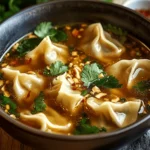Lomo al Trapo is a unique and flavorful way to prepare beef tenderloin, with the salt crust adding an extraordinary depth of flavor while locking in the juices for a tender, succulent bite. The fragrant rosemary and thyme complement the beef’s richness, creating a dish that’s sure to impress at any gathering. The crispy crust gives way to a melt-in-your-mouth experience with every slice.
Perfect for an outdoor grill session or an elegant dinner at home, Lomo al Trapo is both simple to make and utterly delicious. The dramatic presentation of breaking the salt crust will wow your guests, making it a perfect centerpiece for your next special occasion.
Full Recipe:
-
1 whole beef tenderloin (about 2-3 pounds)
-
2 tablespoons olive oil
-
1 tablespoon freshly ground black pepper
-
1 tablespoon fresh thyme leaves
-
2-3 pounds coarse sea salt
-
2 sprigs fresh rosemary
-
2 tablespoons butter (optional)
Directions:
-
Preheat the grill to medium-high heat.
-
Rub the beef tenderloin with olive oil, then coat with black pepper, garlic powder, onion powder, and kosher salt.
-
Dampen the cotton cloth with water, and wrap the seasoned beef tenderloin tightly in the cloth.
-
Place the wrapped tenderloin directly onto the grill. Grill for about 20-25 minutes, turning occasionally, until the meat reaches your preferred level of doneness.
-
Remove the cloth from the beef and let it rest for 5-10 minutes before slicing.
-
Slice the beef tenderloin into thick medallions and garnish with fresh herbs if desired.
Prep Time: 10 minutes | Cooking Time: 25 minutes | Total Time: 35 minutes
Kcal: 340 kcal | Servings: 4 servings
History and Origin
The origins of Lomo al Trapo are deeply tied to the cultural traditions of South America, particularly Colombia, where grilling meat is a central part of the culinary experience. The word “Lomo” refers to the beef tenderloin cut, and “al Trapo” translates to “in cloth.” This grilling technique involves wrapping the meat in a dampened cloth before seasoning it with salt, creating a unique cooking process that protects the tenderloin while it cooks over the hot coals.
This technique likely stems from early barbecue traditions where various methods of wrapping meat—such as using leaves or cloth—were employed to preserve moisture and enhance flavor while cooking over open flames. The cloth serves both as a way to lock in juiciness and as a vessel that prevents the meat from drying out during the grilling process, resulting in a perfect balance of crispy crust and tender interior. Over time, this dish became popular in Colombian and South American grilling culture, and it is often served during large gatherings and celebrations.
The rustic charm of Lomo al Trapo not only highlights the simplicity of the ingredients but also emphasizes the communal aspect of dining. In Colombia, grilling is often a social event, and Lomo al Trapo is a prime example of how cooking can bring people together, with its hands-on preparation and shared enjoyment.
Variations and Adaptations
While Lomo al Trapo is a beloved tradition in Colombia, its preparation has been adapted and embraced by various regions throughout South America. In Argentina, known for its world-class beef and grilling techniques, some may opt to use chimichurri or other marinades to add additional flavor to the meat before grilling. Similarly, in other parts of South America, variations include the addition of herbs like rosemary, thyme, or even a splash of red wine to the meat’s seasoning before it is wrapped in cloth.
Some cooks also experiment by using different cuts of beef, such as ribeye or sirloin, although beef tenderloin is traditionally preferred for its tenderness and flavor. In other variations, the cloth might be soaked in wine or beer to add another layer of flavor, or cooks might use a combination of salt and peppercorns for a more intense seasoning. These adaptations show how versatile Lomo al Trapo can be while maintaining its essential grilling method.
While the traditional recipe uses just basic ingredients—salt, pepper, and olive oil—others may add a touch of garlic or onion powder, depending on their taste preferences. Additionally, some chefs prefer to cook the beef in a traditional outdoor grill, while others opt for a more modern approach using a grill pan or even a barbecue smoker.
Nutritional Information
Lomo al Trapo, primarily composed of beef tenderloin, is rich in protein, making it an excellent source of essential amino acids needed for muscle repair and overall body function. A typical serving of beef tenderloin (about 4 oz) contains around 25-30 grams of protein, which is key to building and maintaining muscle mass.
In addition to protein, beef tenderloin is a great source of iron, a mineral that helps in the production of red blood cells and oxygen transport throughout the body. A serving of beef tenderloin provides about 15% of your daily iron needs, making it an important component of a balanced diet, particularly for those who are active or need to maintain energy levels throughout the day.
However, as a cut of red meat, it’s important to be mindful of its fat content. While beef tenderloin is considered a leaner cut compared to others like ribeye or T-bone, it still contains about 8-10 grams of fat per 4 oz serving. Of this, a small portion is saturated fat, so moderation is key. To keep the dish lighter, consider pairing it with vegetables or a salad to balance the meal and increase fiber intake.
The use of kosher salt in this recipe adds a significant amount of sodium, which can contribute to elevated blood pressure if consumed in excess. For those concerned about sodium intake, consider reducing the amount of salt or using a salt alternative.
Serving Suggestions and Pairings
Lomo al Trapo is a stunning dish that can stand on its own as a centerpiece of any meal. To serve, slice the beef tenderloin into thick medallions, revealing the juicy, tender interior. It pairs beautifully with a variety of sides, particularly roasted vegetables, grilled corn on the cob, or a fresh tomato and avocado salad. The earthy flavors of roasted root vegetables, like carrots and sweet potatoes, complement the rich beef perfectly, and a simple green salad with a light vinaigrette can add freshness to balance out the heaviness of the meat.
If you’re looking to elevate the dish, a chimichurri sauce or garlic butter drizzle adds a burst of flavor. Chimichurri, with its tangy mix of parsley, garlic, vinegar, and olive oil, can add a refreshing contrast to the richness of the beef. Alternatively, a dollop of horseradish cream or mustard can provide a sharp and savory contrast.
For beverages, Lomo al Trapo pairs wonderfully with a full-bodied red wine such as a Malbec or Cabernet Sauvignon. The deep, bold flavors of these wines complement the smoky, savory richness of the beef. If you’re looking for a non-alcoholic option, a tangy lemonade or iced tea with fresh herbs will help cut through the richness of the meat.
Tips and Tricks for Success
To ensure your Lomo al Trapo turns out perfectly, consider these helpful tips:
Advertisement
-
Use the right cloth: Make sure the cloth you use is clean and absorbent. It should be damp, but not soaking wet, to allow the beef to cook evenly while maintaining moisture.
-
Grill over indirect heat: For the best results, grill the beef over indirect heat, allowing the meat to cook slowly and evenly while the cloth protects it from direct flames.
-
Monitor doneness: While Lomo al Trapo is typically cooked to medium-rare or medium, it’s essential to check the internal temperature of the beef. For medium-rare, aim for an internal temperature of 130-135°F, and for medium, aim for 140-145°F.
-
Rest the meat: Allow the beef to rest for 5-10 minutes after grilling to ensure the juices redistribute, ensuring a moist and tender bite.
Potential Health Benefits
Beef tenderloin is an excellent source of high-quality protein, essential for building muscle, repairing tissue, and supporting a healthy immune system. The iron found in beef is particularly beneficial for those with anemia or those who engage in vigorous physical activity, as it helps to transport oxygen in the blood and provides energy.
Additionally, the herbs and spices used in this dish can offer potential health benefits. Olive oil, for example, is a heart-healthy fat that can reduce inflammation and improve cholesterol levels. Garlic, often used in seasoning variations, has been shown to have numerous health benefits, including antimicrobial properties and the ability to support cardiovascular health.
Conclusion
Lomo al Trapo is a delicious and show-stopping dish that offers a perfect balance of simplicity and sophistication. Whether you’re hosting a barbecue or looking to try something new for dinner, this recipe provides a flavorful and tender option that will please any crowd. The beauty of this dish lies in its versatility, allowing you to customize the flavors and sides to suit your preferences. So next time you fire up the grill, consider giving this Colombian favorite a try—you won’t be disappointed!






